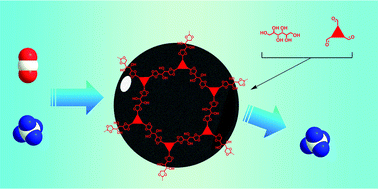Mannitol-based acetal-linked porous organic polymers for selective capture of carbon dioxide over methane†
Abstract
Four acetal-linked porous organic polymers (MAPOP-1–4) have been synthesized by the reaction of multi-aldehyde monomers and mannitol under solvothermal conditions without a template or a metal catalyst. Fourier transform infrared and solid-state 13C cross-polarization/magic-angle-spinning nuclear magnetic resonance spectroscopic measurements were utilized to confirm the structures of the obtained polymers. MAPOPs exhibit high physicochemical stability and a considerable Brunauer–Emmett–Teller specific surface area ranging from 310 to 920 m2 g−1. Owing to their microporous structures, together with their hydroxyl-rich skeletons, MAPOP-1–4 show high carbon dioxide adsorption capability (11.6–13.5 wt% at 273 K and 1.0 bar), heat of adsorption (29.0–31.6 kJ mol−1), and remarkable CO2/CH4 selectivity (8.1–11.6, IAST at 273 K and 1.0 bar). These performances of MAPOP-1–4 make them promising materials in the applications of small gas storage and selective capture.


 Please wait while we load your content...
Please wait while we load your content...